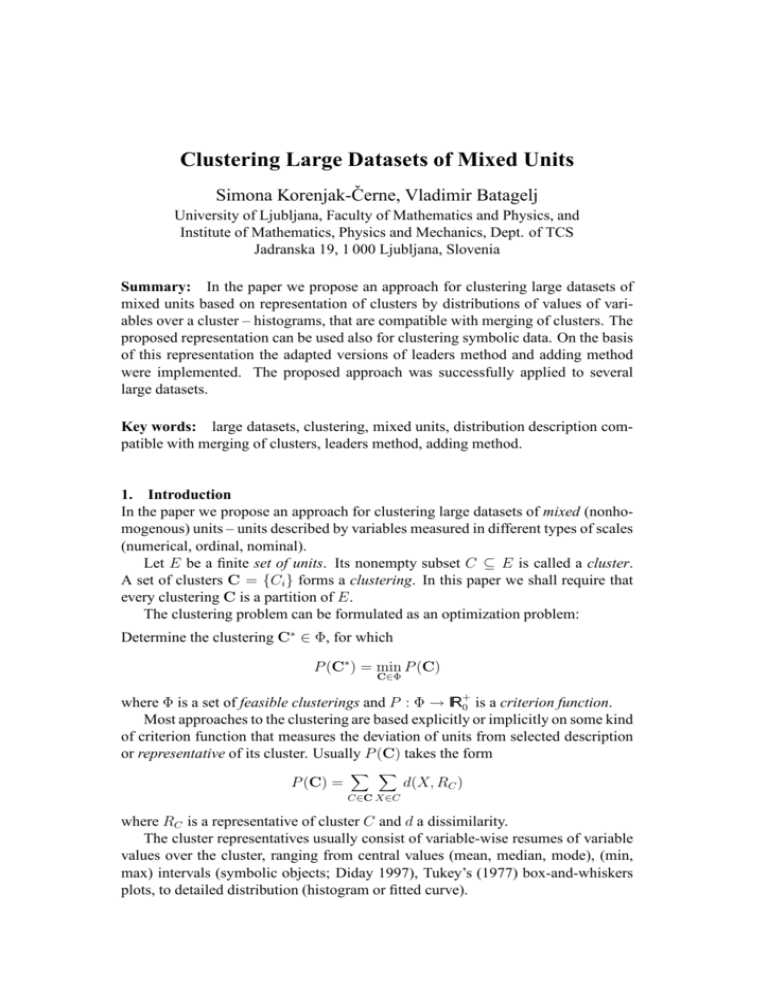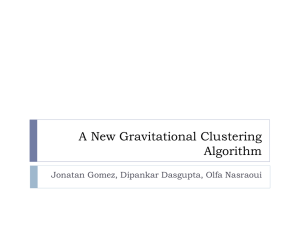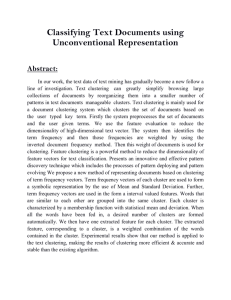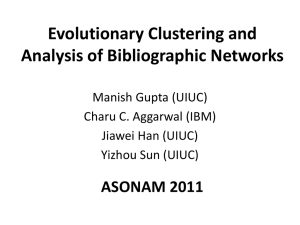Clustering Large Datasets of Mixed Units
advertisement

Clustering Large Datasets of Mixed Units
Simona Korenjak-Černe, Vladimir Batagelj
University of Ljubljana, Faculty of Mathematics and Physics, and
Institute of Mathematics, Physics and Mechanics, Dept. of TCS
Jadranska 19, 1 000 Ljubljana, Slovenia
Summary: In the paper we propose an approach for clustering large datasets of
mixed units based on representation of clusters by distributions of values of variables over a cluster – histograms, that are compatible with merging of clusters. The
proposed representation can be used also for clustering symbolic data. On the basis
of this representation the adapted versions of leaders method and adding method
were implemented. The proposed approach was successfully applied to several
large datasets.
Key words: large datasets, clustering, mixed units, distribution description compatible with merging of clusters, leaders method, adding method.
1. Introduction
In the paper we propose an approach for clustering large datasets of mixed (nonhomogenous) units – units described by variables measured in different types of scales
(numerical, ordinal, nominal).
Let E be a finite set of units. Its nonempty subset C ⊆ E is called a cluster.
A set of clusters C = {Ci } forms a clustering. In this paper we shall require that
every clustering C is a partition of E.
The clustering problem can be formulated as an optimization problem:
Determine the clustering C∗ ∈ Φ, for which
P (C∗ ) = min P (C)
C∈Φ
where Φ is a set of feasible clusterings and P : Φ → IR+
0 is a criterion function.
Most approaches to the clustering are based explicitly or implicitly on some kind
of criterion function that measures the deviation of units from selected description
or representative of its cluster. Usually P (C) takes the form
P (C) =
X X
d(X, RC )
C∈C X∈C
where RC is a representative of cluster C and d a dissimilarity.
The cluster representatives usually consist of variable-wise resumes of variable
values over the cluster, ranging from central values (mean, median, mode), (min,
max) intervals (symbolic objects; Diday 1997), Tukey’s (1977) box-and-whiskers
plots, to detailed distribution (histogram or fitted curve).
In this paper we investigate a description taken from the middle of this range
satisfying two requirements:
• it should require a fixed space per variable;
• it should be compatible with merging of clusters – knowing the description of
two clusters we can, without additional information, produce the description
of their union.
Note that only some of the cluster descriptions are compatible with merging: mean
(as sum and number of units) for numerical variables and (min, max) intervals for
ordinal variables.
2. A cluster representative compatible with merging
In our approach a cluster representative is composed from representatives of each
variable. They are formed, depending on the type of the scale in which a variable
is measured, in the following way. Let {Vi , i = 1, . . . , k} be a partition of the range
of values of variable V . Then we define for a cluster C the sets
Q(i, C; V ) = {X ∈ C : V (X) ∈ Vi }, i = 1, . . . , k
where V (X) denotes the value of variable V on unit X.
In the case of ordinal variable V (numerical scales are a special case of ordinal
scales) the partition {Vi , i = 1, . . . , k} usually consists of intervals determined by
selected threshold values t0 < t1 < t2 < t3 < · · · < tk−1 < tk , t0 = inf V ,
tk = sup V .
For nominal variables we can obtain the partition, for example, by selecting k−1
values t1 , t2 , t3 , . . . , tk−1 from the range of variable V (usually the most frequent
values on E) and setting Vi = {ti }, i = 1, . . . , k − 1; and putting all the remaining
values in class Vk .
Using these sets we can introduce the concentrations
q(i, C; V ) = card Q(i, C; V )
and relative concentrations
p(i, C; V ) =
It holds
k
X
q(i, C; V )
card C
p(i, C; V ) = 1
i=1
The description of variable V over C is the vector of concentrations of V .
Note that in the special case C = {X} we have
p(i, C; V ) =
(
1 X ∈ Q(i, C; V )
0 otherwise
Similarly we can consider a missing value on V for unit X by setting p(i, {X}; V ) =
1
, i = 1, . . . , k. Using concentrations we can describe also symbolic data.
k
It is easy to see that for two clusters C1 and C2 , C1 ∩ C2 = ∅ we have
Q(i, C1 ∪ C2 ; V ) = Q(i, C1 ; V ) ∪ Q(i, C2 ; V )
q(i, C1 ∪ C2 ; V ) = q(i, C1; V ) + q(i, C2 ; V )
The description is compatible with merging.
The threshold values are usually determined in a way that for the given set of
units E (or the space of units E) it holds p(i, E; V ) ≈ k1 , i = 1, . . . , k.
As a compatible description of nominal variable over a cluster C also its range
V (C) can be used, since we have
V (C1 ∪ C2 ) = V (C1 ) ∪ V (C2 )
3. Dissimilarity
Most clustering methods are based on some dissimilarity between clusters or a unit
and a cluster. For our descriptions we define
d(C1 , C2 ; V ) =
k
1X
|p(i, C1 ; V ) − p(i, C2 ; V )|
2 i=1
and in the case of nominal variable described by set of values
d(C1, C2 ; V ) =
card (V (C1 ) ⊕ V (C2 ))
card (V (C1 ) ∪ V (C2 ))
We shall use the abbreviation d(X, C; V ) = d({X}, C; V ). In both cases it can be
shown that
• d(C1 , C2 ; V ) is a semidistance on clusters; i.e.
1. d(C1, C2 ; V ) ≥ 0
2. d(C, C; V ) = 0
3. d(C1, C2 ; V ) + d(C2 , C3; V ) ≥ d(C1 , C3 ; V )
• d(C1 , C2 ; V ) ∈ [0, 1]
and for the vector representation also
X ∈ Q(i, E; V ) ⇒ d(X, C; V ) = 1 − p(i, C; V )
The semidistances on variables can be combined into a semidistance on units by
d(C1, C2 ) =
m
X
j=1
αj d(C1 , C2 ; Vj ),
m
X
αj = 1
j=1
where m is the number of variables and αj weights (Batagelj and Bren, 1995); often
αj = m1 .
4. Clustering procedures
The proposed approach allows us to first recode the original nonhomogenous data
to a uniform representation by integers – indices of intervals. For the recoded data
efficient clustering procedures can be built by adapting leaders method (Hartigan,
1975) or adding clustering method (Batagelj and Mandelj, 1993). In this paper,
because of limited space, we shall describe only the procedure based on the dynamic
clusters method (a generalization of the leader method).
To describe the dynamic clusters method for solving the clustering problem let
us denote (Diday, 1979; Batagelj, 1985): Λ a set of representatives; L ⊆ Λ a
representation; Ψ a set of feasible representations; W : Φ × Ψ → IR+
0 extended
criterion function; G : Φ × Ψ → Ψ representation function; F : Φ × Ψ → Φ
clustering function and suppose that the following conditions are satisfied:
W0. P (C) = minL∈Ψ W (C, L)
the functions G and F tend to improve (diminish) the value of the extended criterion
function W :
W1. W (C, G(C, L)) ≤ W (C, L)
W2. W (F (C, L), L) ≤ W (C, L)
then the dynamic clusters method can be described by the scheme:
C := C0 ; L := L0 ;
repeat
C := F (C, L);
L := G(C, L)
until the goal is attained
To this scheme corresponds the sequence vn = (Cn , Ln ), n ∈ IN determined by
relations
Cn+1 = F (Cn , Ln )
and
Ln+1 = G(Cn+1 , Ln )
and the sequence of values of the extended criterion function un = W (Cn , Ln ).
Let us assume the following model C = {Ci }i∈I , L = {Li }i∈I , L(X) = {Li :
X ∈ Ci } and further L = [L(V1 ), . . . , L(Vm )], L(V ) = [s(1, L; V ), . . . , s(k, L; V )],
Pk
j=1 s(j, L; V ) = 1 and
d(C, L; V ) =
k
1X
|p(j, C; V ) − s(j, L; V )|
2 j=1
For
W (C, L) =
X
d(X, L(X)) =
X∈E
X
i∈I
where
p(C, L) =
X
X∈C
d(X, L)
p(Ci , Li )
we define F (L) = {Ci′ } by
X ∈ Ci′ : i = min Argmin{d(X, Lj ) : Lj ∈ L}
j
each unit is assigned to the nearest leader; and we define G(C) = {L′i } by
L′i = argmin p(C, L)
L∈Ψ
To solve the last optimization problem we consider
p(C, L; V ) =
X
d(X, L; V ) = card(C) −
k
X
q(j, C; V )s(j, L; V )
j=1
X∈C
This expression has a minimum value iff the sum has a maximum value. The unique
symmetric optimal solution is
′
s(i, L ; V ) =
(
1
t
j∈M
0 otherwise
where M = {j : q(j, C; V ) = maxi q(i, C; V )} and t = card M.
Evidently W0, W1 and W2 hold. It holds also P (C) = W (C, G(C)).
Usually t = 1 – we include in the representative of a cluster the most frequent
range of values of variable on this cluster. This provides us with very simple interpretations of clustering results.
For example, in a clustering of types of cars we obtained among 14 clusters:
Cluster 5: (42 units) coupes
doors = 2, height(mm) ∈ ( – , 1388 ], power(KW) ∈ ( 125, – ), acceleration time(s)
∈ ( – , 9.1 ], max speed(km/h) ∈ ( 215 , – ), price(1000 SIT) ∈ ( 6550, – ).
Cluster 8: (57 units) minivans
doors = 5, passengers = 7, length(mm) ∈ ( 4555, 4761 ], height(mm) ∈ ( 1490,
– ), fuel tank capacity(l) ∈ ( 66, 76 ], weight(kg) ∈ ( 1540, – ), wheelbase(mm) ∈
( 2730, – ).
Cluster 9: (193 units) small-cars
doors = 4, passengers = 5, length(mm) ∈ ( – , 4010 ], width(mm) ∈ ( – , 1680 ],
luggage capacity(l) ∈ ( –, 279 ], fuel tank capacity(l) ∈ ( –, 48 ], weight(kg) ∈ ( – ,
940 ], power(KW) ∈ ( – , 55 ], torque ∈ ( – , 124 ], brakes = disc/drums, max
speed(km/h) ∈ ( – , 163 ], price(1000 SIT) ∈ ( – , 2100 ].
Cluster 13: (62 units) sport-utility
doors = 5, height(mm) ∈ ( 1490, – ), fuel tank capacity(l) ∈ ( 76, – ), weight(kg) ∈
( 1540, – ), cargo capacity(l) ∈ ( 560, – ), torque ∈ ( 270, – ).
For another criterion function
W (C, L) = α
X
i∈I
d(Ci, Li ) +
X
p(Ci , Li )
i∈I
where α is a large constant, the first term can be set to 0 by setting s(j, Li ; V ) =
p(j, Ci ; V ), j = 1, . . . , k. If this defines the function G, and F is defined as in
the previous case, we obtain a procedure which works very well on real data. We
conjecture that in this case it holds in general that W (Ci+1 , Li+1 ) ≤ W (Ci , Li )
and W (Ci+1 , Li ) ≤ W (Ci, Li−1 ). Note also that for the obtained (local) minimum
(C∗ , L∗ ) it holds
P (C∗ ) = min W (C∗ , L) = W (C∗ , G(C∗ )) =
L∈Ψ
X
p(C, G(C))
C∈C∗
5. Conclusion
We successfully applied the proposed approach to the dataset of types of cars (1349
units) and also to some large datasets from AI collection
http://www.ics.uci.edu/˜mlearn/MLRepository.html
An extended version of this paper is available at
http://vlado.fmf.uni-lj.si/pub/cluster/
References
Batagelj, V. (1985). Notes on the dynamic clusters method, in: IV conference on
applied mathematics, Split, May 28-30, 1984. University of Split, Split, 139146.
Batagelj, V. & Bren, M. (1995). Comparing Resemblance Measures, Journal of
Classification, 12, 1, 73-90.
Batagelj, V. & Mandelj, M. (1993). Adding Clustering Algorithm Based on L-W-J
Formula, Paper presented at: IFCS 93, Paris, 31.aug-4.sep 1993.
Diday, E. (1979). Optimisation en classification automatique, Tome 1.,2.. INRIA,
Rocquencourt, (in French).
Diday, E. (1997). Extracting Information from Extensive Data sets by Symbolic
Data Analysis, in: Indo-French Workshop on Symbolic Data Analysis and its
Applications, Paris, 23-24. September 1997, Paris IX, Dauphine, 3-12.
Hartigan, J.A. (1975). Clustering Algorithms, Wiley, New York.
Tukey, J.W. (1977). Exploratory Data Analysis, Addison-Wesley, Reading, MA.








